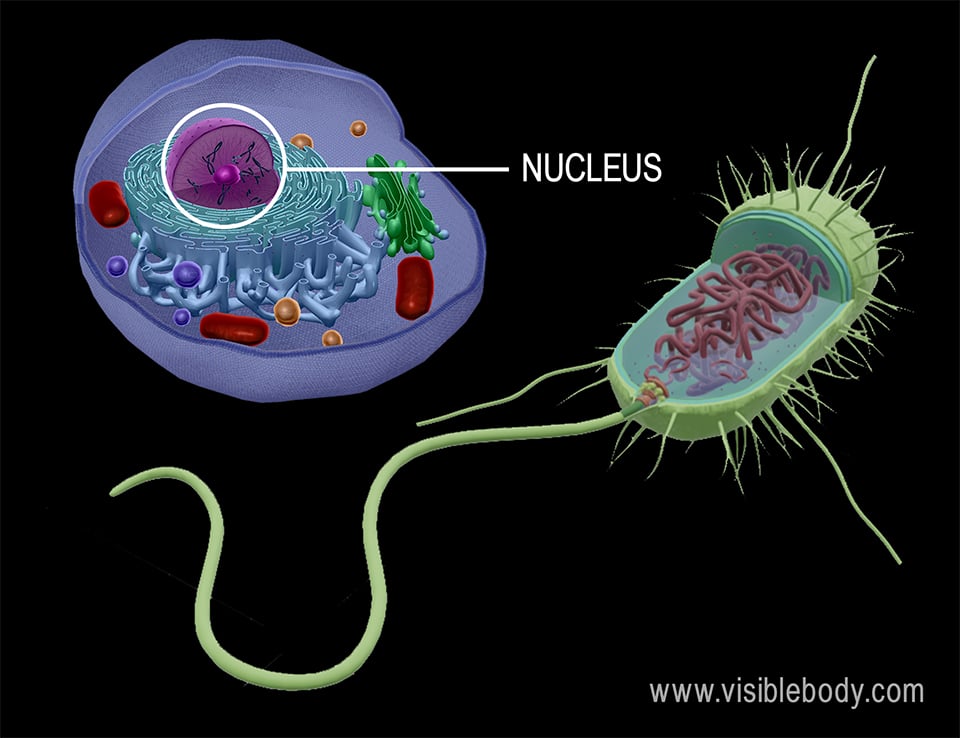Since prokaryotic cells typically have only a single, circular chromosome, they can replicate faster than eukaryotic cells. In fact, a prokaryotic cell can undergo two rounds of DNA replication before the cell, itself, has divided. This means that DNA replication can occur during cell division in prokaryotes.
Since eukaryotic cells typically have multiple linear chromosomes, capped with telomeres, eukaryotic DNA replication and cell division (mitosis and meiosis) are a bit more complicated. In eukaryotic cells, DNA replication occurs before mitosis begins, and it can’t occur while the cell is dividing. In addition, the telomeres—repeating DNA sequences at the ends of each chromosome—limit the number of times a cell can divide before it dies or becomes senescent. Each time a typical or somatic eukaryotic cell divides, the telomeres get shorter.

The key difference between prokaryotic and eukaryotic cells is that eukaryotic cells have a membrane-bound nucleus (and membrane-bound organelles), whereas prokaryotic cells lack a nucleus. In eukaryotic cells, all the chromosomes are contained within the nucleus. In prokaryotic cells, the chromosome is located in a region of the cytoplasm called the nucleoid, which lacks a membrane.
One interesting implication of this difference in the location of eukaryotic and prokaryotic chromosomes is that transcription and translation—the processes of creating an RNA molecule and using that molecule to synthesize a protein—can occur simultaneously in prokaryotes. This is possible because prokaryotic cells lack a nuclear membrane, so transcription and translation occur in the same region. As the RNA is being transcribed, ribosomes can begin the translation process of stringing together amino acids. In contrast, in eukaryotic cells, transcription always occurs first, and it takes place within the nucleus. The RNA molecule needs to undergo editing before it leaves the nucleus. Then, translation is conducted by a ribosome in the cytoplasm.
In general, eukaryotic cells contain a lot more genetic material than prokaryotic cells. For example, each human cell has around 2m, or 3 billion base pairs, of DNA that must be compacted to fit within the nucleus.
In eukaryotic cells, chromatin consists of all the DNA within the nucleus and its associated proteins, called histones. Eukaryotic chromosomes are composed of chromatin, and each consists of two complementary strands of DNA coiled tightly around histones. The structure of chromatin is scaffolded, with three distinct levels. First, the DNA is wrapped around clusters of histones, forming nucleosomes that are connected by linker DNA. Then, the linked nucleosomes undergo supercoiling. Like beads on a string, the connected nucleosomes loop around each other to form 30-nm solenoid fiber. The 30-nm chromatin fiber is compacted even further just before mitosis occurs, and its coils fold and compress into a 250nm-wide fiber.
Prokaryotic cells also have a lot of DNA, but the molecules don’t need to be packaged up quite as tightly as they do in eukaryotic cells. E. coli has around 1.6mm, or 4 million base pairs, of DNA—compare this to the 2m of DNA inside each human cell.
Although most prokaryotic cells don’t use histones to coil up their DNA, they have various proteins and enzymes that introduce folds to produce a complex, compacted structure.
Here is a basic summary of the key differences between eukaryotic and prokaryotic chromosomes.
| Eukaryotic Chromosome | Prokaryotic Chromosome | |
|---|---|---|
| Shape | Linear | Circular |
| Size | Large | Small |
| Number | Multiple | Single |
| Location | Nucleus | Nucleoid (region in cytoplasm) |
| Storage proteins | Histones | Nucleoid-associated proteins |
An overview of chromosome structure and cell division from Kenyon College.
Annunziato, A. (2008) “DNA Packaging: Nucleosomes and Chromatin.” Nature Education 1(1):26
Ralston, A. (2008) “Simultaneous gene transcription and translation in bacteria.” Nature Education 1(1):4
When you select "Subscribe" you will start receiving our email newsletter. Use the links at the bottom of any email to manage the type of emails you receive or to unsubscribe. See our privacy policy for additional details.